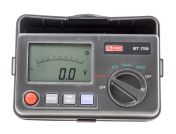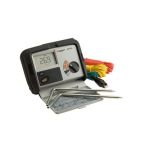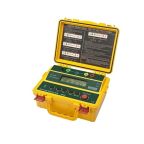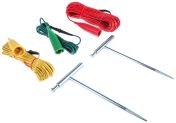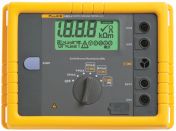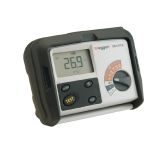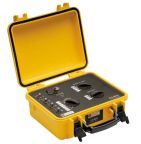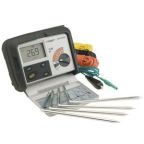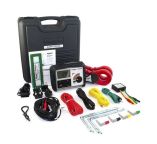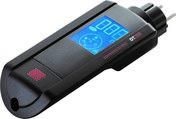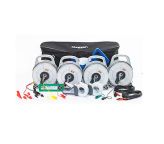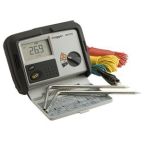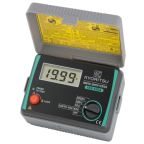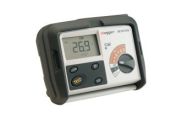Earth Testers
Earth testers, also known as earth ground testers or earth resistance testers, are essential electrical instruments for electrical safety, used to verify that appliances, installations, and equipment are properly grounded. Effective grounding ensures that electrical faults, surges, or lightning strikes can safely dissipate into the earth, protecting both people and equipment from electric shock, fire, or damage.
What Types of Earth Testers Are Available?
Earth testers are types of devices ideal for testing and measuring electrical systems to ensure they are grounded, and the current has a safe path to earth, in case of utility over voltage or lightning strike. This verification is vital for both equipment protection and personnel safety.
Ground and earth testers are available in a variety of formats including:
- Clamp-On Earth Testers: These allow non-intrusive earth tester testing of ground loops without disconnecting the system, ideal for live systems or where disconnection is impractical.
- Desktop/Bench Earth Testers: Designed for laboratory or controlled environments, these offer advanced features and high accuracy for detailed analysis.
- Handheld Earth Resistance Test Meters: Portable and versatile, these digital earth testers are perfect for fieldwork and on-site inspections.
- Plug-In Ground Testers: Designed for quick checks of outlet grounding and wiring safety, typically used for basic checks in residential or office settings.
Modern earth resistance test meters often combine multiple test methods, such as 2-pole, 3-pole, 4-pole, and clamp-on, offering flexibility for a wide range of applications.
Why Is Earthing Testing Important?
Conducting regular earth tester resistance checks is crucial for:
- Safety: Ensures that electrical systems are safe for users by providing a low-resistance path for fault currents, reducing the risk of electric shock.
- Equipment Protection: Prevents damage to sensitive equipment by stabilising voltage levels and providing a safe discharge path for surges or lightning strikes.
- Regulatory Compliance: Many electrical standards require periodic earth resistance testing to ensure installations meet safety regulations.
- Operational Reliability: Proper grounding minimises downtime and prevents costly repairs caused by electrical faults.
How Do Earth Testers Work?
Earth testers function by measuring the resistance between a grounding system and the actual earth. This crucial measurement verifies whether the grounding system is effective in providing a safe pathway for the dissipation of electrical faults.
Several methods are employed by ground testing meters to perform these measurements:
- 3-Point Method (Fall-of-Potential): This is a common method that involves inserting two auxiliary test spikes into the ground at known distances from the grounding electrode. The tester applies a current between one auxiliary spike and the grounding electrode, while the voltage drop is measured between the grounding electrode and the second auxiliary spike.
- 2-Point Method: This method typically involves using an existing known good ground as one of the measurement points, along with the grounding electrode being tested. Suitable for quick checks but less accurate than the 3-point method.
- Clamp-on Method: This technique is particularly useful for systems that cannot be disconnected. The clamp-on meter measures the earth resistance of a ground loop by inducing a voltage within the loop and measuring the resulting current, without the need for test spikes.
- 4-Point Method: Used for soil resistivity measurements, this ground testing method is important when designing new grounding systems or assessing soil conditions.
The basic components of an earth tester include test spikes, test leads, and the tester unit itself.
Key Features to Consider When Choosing an Earth Tester
When selecting an earth tester for your needs, several key features should be carefully considered to ensure accurate measurements, ease of use, and suitability for your specific applications.
- Measurement Range & Accuracy: The earth tester should have a measurement range that accommodates the expected resistance values of your grounding systems (typically from 0.01 Ω to 50 kΩ).
- Type of Test: Some earth testers offer compatibility with various testing methods, including 2-pole, 3-pole, 4-pole, and clamp-on testing.
- Ease of Use: The earth tester should be user-friendly, with a clear display and intuitive controls. Features like automatic ranging, data hold, and clear instructions can significantly simplify the testing process.
- Portability & Durability: If you need to perform tests in various locations, a lightweight and rugged handheld tester with a protective case will be advantageous. Consider the build quality to ensure the tester can withstand the conditions of your work environment.
- Safety Ratings: Ensure the earth tester complies with relevant safety standards and carries appropriate safety ratings.
- Accessories: Check if the earth tester comes with included test leads, spikes, clamps, and carrying cases for convenience and completeness
Applications of Earth Testers in Different Industries
Earth testers are indispensable tools across a wide range of industries in Malaysia, ensuring the safety of electrical installations and equipment. Proper grounding is critical to protect personnel and infrastructure from electrical faults and lightning strikes.
- Construction: In the construction industry, earth testers are used to verify the grounding of temporary electrical setups on building sites, as well as the permanent grounding systems of new structures.
- Telecommunications: Telecommunications infrastructure relies heavily on properly grounded equipment to protect sensitive electronic systems. Earth testers are used to regularly check the grounding of transmission towers, equipment shelters, and data centres.
- Utilities & Substations: For power generation, transmission, and distribution utilities, earth testing is a fundamental safety and operational procedure. Substations, in particular, require rigorous testing of their grounding grids to ensure the safe dissipation of fault currents and the protection of high-voltage equipment.
- Oil & Gas / Mining: Industries such as oil and gas and mining operate in potentially hazardous environments where the risk of electrical faults and static discharge is significant. Earth testers are crucial for verifying the grounding of equipment and structures to prevent explosions and ensure the safety of personnel.
- Renewable Energy: Earth testers play a vital role in ensuring the safety and efficiency of renewable energy systems. Proper grounding protects the inverters, panels, and turbines from lightning strikes and electrical faults.
How to Use an Earth Tester Safely and Accurately
Using an earth tester correctly is crucial for obtaining reliable measurements and ensuring the safety of yourself and the electrical systems you are testing. Here’s a guide with some pointers on how to ensure safe and accurate operation:
- Preparation: Always read your tester's manual thoroughly and inspect all equipment for damage before use. Wear appropriate PPE like insulated gloves and safety glasses. If possible, isolate the system being tested from the main power supply.
- Test Setup:
- 3-Point (Fall-of-Potential): Position the grounding electrode. Insert two auxiliary spikes in a line away from it (refer to manual for distance). Connect leads from tester to electrode and spikes.
- 2-Point: Connect one tester lead to the grounding electrode and the other to a known good ground reference.
- Clamp-On: Ensure the ground loop is complete and clamp the meter securely around the earth conductor.
- Reading Results: Follow your tester's instructions to take the reading and allow it to stabilize.
- Common Mistakes to Avoid: Ensure correct spike placement (for 3-point), good contact for all connections (wet soil if needed), avoid testing near underground metal or power lines, and always follow your tester's manual.
- Safety Tips: Always ensure circuits are de-energised before testing, unless using a specific live-testing clamp meter. Prior to inserting test spikes, check for any buried utilities. If you have any doubts about the testing procedure, consult a qualified electrical professional. Finally, ensure your tester undergoes regular calibration for accurate results.
Why Choose RS for Earth Testers and Earth Tester Kits?
RS Malaysia offers a comprehensive selection of digital earth testers and earth tester kits from market-leading brands such as Fluke, Megger, and Chauvin Arnoux. Explore our extensive online catalogue to find the perfect earth tester kits, digital multimeters, or pressure sensors for your next project.
For detailed information regarding our delivery services, including estimated delivery times and associated costs, please visit our dedicated Delivery Information page. We are committed to providing prompt and reliable delivery to support your testing needs across Malaysia.
Popular Searches
Related links
- Electrical Test & Measurement Accessories
- Ohmmeters
- Insulation Testers
- Fluke Earth Tester Kit
- Megger MFT1721 Multifunction Tester Earth Resistance Measurement With Wireless
- Fluke SMFT-1000 Multifunction Tester Earth Resistance Measurement With Wireless
- Megger MFT1711 Multifunction Tester 500 V Earth Resistance Measurement With Wireless
- Megger DET3TC Earth Tester, 2kΩ CAT IV 100 V


